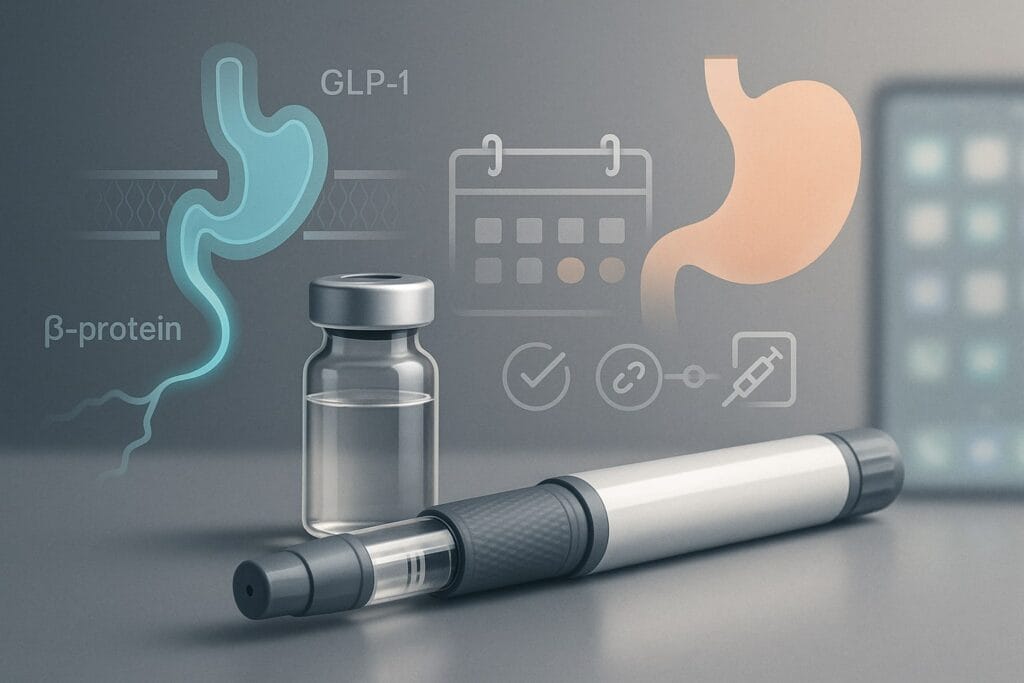Pfizer has rejoined the weight-loss race with a $4.9bn move for Metsera. Beyond deal size, the strategic question is sharper: can pairing an amylin analogue with a monthly GLP-1 finally blunt the gastrointestinal side effects that limit real-world persistence?
Table of Contents
ToggleWhat Pfizer actually bought
On 22 September, Pfizer agreed to acquire Metsera for $47.50 per share in cash (enterprise value ~$4.9bn) plus a contingent value right of up to $22.50 per share, with closing targeted for Q4 2025. For Pfizer—coming off its own setbacks with oral GLP-1 danuglipron—this is a re-entry into a market forecast to exceed $100bn later this decade.
Metsera brings four clinical-stage obesity programmes built around ultra-long-acting, “fully-biased” GLP-1 peptides and a monthly amylin analogue designed for combination and eventual co-formulation. The lead GLP-1, MET-097i, has shown a ~380-hour half-life in early studies, supporting once-monthly dosing. The amylin candidate, MET-233i, is being tested both alone and with MET-097i; early Phase 1 readouts (6 September) reported up to 8.4% placebo-subtracted weight loss by Day 36.
The operational message is clear: Pfizer wants fewer injections, simpler titration, and combinable hormones that can be manufactured at scale and shipped through streamlined channels. Metsera’s own framing—“nutrient-stimulated hormone” (NuSH) targets; HALO™ lipidation for durability; and MOMENTUM™ for oral bioavailability—spells out that ambition.
Why amylin matters—and what the evidence says so far
The case for amylin is physiological. Endogenous amylin complements insulin to slow gastric emptying and promote satiety, and there is long-standing preclinical and clinical rationale that amylin + GLP-1 should produce deeper, more durable weight loss—potentially at lower GLP-1 exposure. That, in theory, could ease nausea/vomiting that dog this class.
Recent external data are encouraging on efficacy—but mixed on tolerability:
- Novo Nordisk’s cagrilintide + semaglutide (“CagriSema”) delivered top-tier weight loss in diabetes and non-diabetes populations, with Phase 3 programmes now under way. However, GI adverse events were common (≈80% vs 40% placebo), broadly in line with GLP-1 class effects.
- Roche/Zealand’s petrelintide (weekly amylin) is being advanced both solo and in combos; Roche has explicitly touted improved tolerability potential versus current therapies, with a Phase 2b underway. That promise remains to be proven in head-to-head or add-on studies.
On the benchmark GLP-1s, the GI burden is well characterised: in the STEP programme for semaglutide 2.4 mg, nausea (~44%), diarrhoea (~30%), vomiting (~25%) were frequent, though discontinuations for GI AEs were low (~4%) with dose-escalation. Tirzepatide shows similar patterns, with GI-related discontinuation ranging ~1–10% across SURPASS/SURMOUNT. These are not catastrophic numbers—but they are high enough to drive drop-offs in everyday care if titration is rushed or supply is patchy.
Bottom line: the amylin “antidote” thesis is unproven. The combination can amplify efficacy; whether it reduces GLP-1-type GI issues depends on dose, ramp, formulation, and possibly biased signalling properties of the GLP-1 backbone. That is precisely where Metsera’s “fully-biased” approach could be consequential.

The “fully-biased” GLP-1 angle: a real differentiator or clever branding?
“Biased agonism” at GPCRs such as GLP-1R—preferentially engaging G-protein pathways while avoiding β-arrestin signalling linked to desensitisation—has moved from theory to animal data and early human hypotheses. In principle, a G-protein-biased GLP-1 could maintain appetite suppression and metabolic effects while modulating off-target signalling that contributes to tolerability issues. Whether that translates in people remains an empirical question; Metsera’s claim of “fully-biased” is unusual and invites close reading of forthcoming clinical datasets.
For now, the company points to single-dose and 12-week data supporting once-monthly dosing for MET-097i, along with that ~380-hour half-life; fuller peer-reviewed human evidence on bias–tolerability links will be a major watch-item.
Monthly dosing: convenience, capacity—and a cautionary tale
If Metsera (and now Pfizer) can deliver monthly injections without compromising tolerability, that is a meaningful consumer and payer advantage. Convenience matters; less frequent regimens also lower logistics friction for prescribers and pharmacies, and could reduce peptide API demand per patient-year if exposures are optimised—important in a market still normalising from shortages.
But monthly is not a magic wand. Amgen’s MariTide, another monthly candidate with a distinct dual mechanism, posted impressive efficacy—but high GI-related discontinuations at top doses (up to 27%) in Phase 2 reminded investors that longer intervals can make each dose a larger physiological “ask” unless titration is careful. Expect Pfizer to build gentle uptitration into trial designs.
There is also a maintenance-dosing trend—data suggest that spacing GLP-1 shots (e.g., every two weeks) can retain a substantial share of weight loss during maintenance phases. Monthly regimens might fit naturally into that paradigm if initial induction can be tolerated and sustained.
Distribution is changing: direct-to-patient and telehealth scrutiny
The channel strategy is evolving just as fast as the chemistry. Zealand has openly floated selling an amylin-based obesity drug direct to patients, bundling telehealth and fulfilment—mirroring how some Big Pharma players now operate cash-pay portals. At the same time, U.S. senators have raised conflict-of-interest concerns about pharma–telehealth partnerships, explicitly naming Pfizer and Eli Lilly. For Pfizer–Metsera, this creates both an obvious route to market—and a regulatory optics risk.
If Pfizer can pair monthly convenience with transparent, patient-first telehealth pathways (clear prescribing criteria, careful titration, proactive AE management), it may expand the cash-pay obesity segment while keeping pressure on traditional PBM channels. The prize is stickier persistence; the trap is over-promising “gentler” side-effect profiles that the data do not yet support.
Pricing, payers and the “GI tax”
Even as supply pressures ease, payers are sharpening controls; the GI profile of a regimen functions like a hidden “tax” on persistence and total cost of care if it drives discontinuations or clinic visits. In semaglutide and tirzepatide trials, true GI discontinuations are single-digit percentages with careful ramp-up—yet real-world persistence only recently improved as prescribers learned to manage AEs. Any amylin-GLP-1 combo will be judged on whether it keeps patients on therapy at 12–24 months without extra hand-holding.
For Pfizer, an eventual co-formulation that achieves equal or better efficacy at lower GLP-1 exposure—and thereby fewer GI complaints—would be a strong payer story. But evidence from CagriSema so far suggests GI AEs remain common, so the burden of proof is high.
Timelines and what to watch next
- Deal close: targeted Q4 2025, pending shareholder and regulatory approvals.
- Development cadence: Metsera indicates late-stage plans for MET-097i and ongoing combo work with MET-233i; MET-233i has early human data and could “pace” the combo path.
- Launch horizon: external sell-side takes peg first launches around 2028–2029, for monthly GLP-1 and follow-on combos—late enough that Novo and Lilly will have entrenched next-gen assets, but early enough for a serious challenge if tolerability and convenience land.
- Readouts to scrutinise:
- GI AE rates and discontinuations vs. weekly GLP-1s under identical titration;
- Combo vs monotherapy dose-response showing efficacy at lower GLP-1 exposures;
- Co-formulation stability (same vial/pen) and manufacturing yields;
- Maintenance-phase spacing data (q2–4 weeks) with weight-loss retention.
The Industry Examiner view
Pfizer’s purchase reads as a wager on formulation science—specifically that biased GLP-1 signalling + amylin can produce a monthly product that patients can actually live with, not merely trial through. The magnitude of the bet puts pressure on the science to separate convenience from complacency: monthly dosing helps only if each dose is kinder.
The unique angle most headlines miss is that tolerability may be solved in the receptor, not the calendar. If Metsera’s “fully-biased” GLP-1 backbone meaningfully decouples efficacy from nausea—and amylin lets Pfizer dial down GLP-1 intensity—then the combination could reduce the “GI tax” that payers and prescribers quietly price in today. That is a high bar—and the CagriSema experience warns against assuming amylin is inherently gentler. For now, the claim remains plausible but unproven.
The commercial upside, should the science hold, is substantial: monthly, co-formulated pens, telehealth-friendly fulfilment, and a maintenance-ready dosing profile that improves persistence without overburdening clinics. Equally, regulators are watching the distribution tactics closely, and investors have learned to read drop-out lines as carefully as weight-loss curves.
As data roll out, watch whether Pfizer leans into objective GI endpoints (e.g., validated nausea indices, rescue-medication rates) and real-world persistence pilots rather than headline percentage-loss alone. That will tell you if Metsera’s science is doing the heavy lifting—or if the story is still, at heart, about how often the needle goes in.











